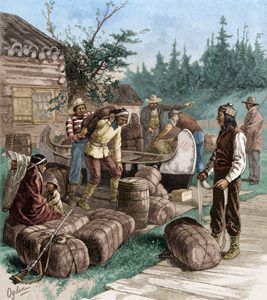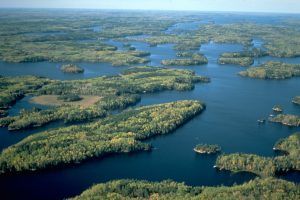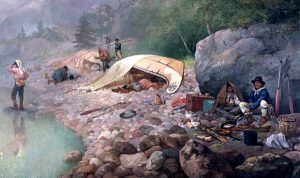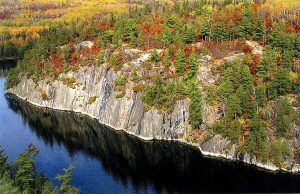
Voyageurs National Park, Minnesota courtesy Wikipedia
Voyageurs National Park near International Falls, Minnesota, commemorates the voyageurs — French-Canadian fur traders who were the first European settlers to travel through the area frequently.
Located where lakes, glacial scoured rock basins, forested uplands, rocky lakeshores, grassy portages, marshes, bogs, and beaver ponds abound, Voyageurs National Park brings alive the history of the adventurous and brave French Canadian fur trading canoemen known as the voyageurs. The park protects a 56-mile stretch of the historic water route the voyageurs used to move trade goods across the region.
In the 1700s, the demand for fur goods, hats, and coats rose exponentially in Europe, prompting many businessmen to look to North America for furs that could be transformed into fashionable and profitable fur products. Trapping began on the east coast and eventually moved westward after the depletion of the fur-bearing animals in the East. As the fur trade moved westward, fur trading companies, including the Northwest and Hudson Bay Companies, began to rely on voyageurs to move beaver, other pelts, and additional trade goods between Montreal and the Canadian Northwest.
To move these goods, the voyageurs used the extensive waterways that dominate the region, becoming the first Europeans to explore the Northwest Territory and engage the American Indians of this area in a large-scale fur trading industry. Their water route became so well established that by the end of the American Revolution, the voyageurs’ “customary waterway” between Lake Superior and Lake of the Woods became the basis for the international boundary between the United States and Canada.
Voyageurs National Park encompasses nearly 84,000 acres of water, including four major lakes and 26 interior ones. The best way to navigate the area is via the water. The voyageurs paddled up to 16 hours daily and relied on American Indian tribes such as the Ojibwe for furs, guide services, clothing, food, and medicine. They used the European trade goods they carried with them to barter for furs the Ojibwe trapped. The fur trade provided a “middle ground” where the Ojibwe and the voyageurs shared and traded goods, ideas, cultural practices, technologies, and diseases, each affecting and influencing the other.
Descriptions of the voyageurs portray them as adventurous, brave, and burly men who were usually optimistic and cheerful. Their reputation for cheerfulness is noteworthy given that they sometimes paddle large “North Canoes” for up to 16 hours a day and often dealt with intense natural elements. The voyageurs outfitted themselves in functional clothing of practical material. Their toques (hats) of red or blue wool helped keep them warm and provided a place to store their tobacco. Their ceinture fléchée (sashes) were six inches wide and six feet long, placed around their waist to provide back support and protect against strangulated hernias. Their guetre (leggings) of bright-colored wool prevented chaffing and discouraged leeches from crawling up their bodies. While at the park, visitors can envision the colorfully clad voyageurs paddling along Kabetogama Lake and Rainy Lake or walking Grassy Portage, Cutover Island, and Surveyor’s island, where they sometimes stopped before traversing the large waters of Rainy Lake and remember each carefully selected article of clothing that served an important purpose.
The voyageurs used “North Canoes” to transport the furs and trade goods they collected on their voyages between trading posts and forts. Originally made by the Ojibwe and later at Fort Lac la Pluie on the Rainy River, the “North Canoe” was light, easily navigable, and quickly repaired with native materials. The canoes were made of birch bark, cedar, and split spruce roots and used a sealing compound made from cedar ashes mixed with heated pine pitch. They were 26 feet long and four to five feet wide and could hold a crew of eight men. The canoe weighed between 2,000 and 3,000 pounds when filled with men and cargo. Today, visitors can paddle back in voyageurs’ history in a 26-foot North Canoe. The park offers guided trips aboard these canoes at the Rainy Lake, Kabetogama Lake, and Ash River visitor centers each summer.
On land, in a canoe, or on a boat in the park, visitors can envision the voyageurs portaging around places like Grassy Portage and Kettle Falls with their large canoes. Kettle Falls in the Kettle Falls Historic District is a natural barrier in the chain of lakes and rivers between the Canadian and United States borders. Voyageurs had to circumvent this barrier to trade and transportation.
Other sites in the park also provide a sense of what it would have been like for the voyageurs. Historic fur trade artifacts, including brass buttons, kettle fragments, muskrat spears, spoons, knives, and razors, have been found throughout Sand Point, on islands in Sand Point Lake, and along the shoreline of Rainy Lake from Kettle Falls to Soldier’s Point. The many hiking trails allow visitors to experience the terrain the voyageurs traversed.
Around 1840, the demand for fur ended as silk replaced fur as the desirable fashion, making the work of the voyageurs unnecessary. After the voyageurs, people continued to use the area in and around Voyageurs National Park for logging, a mini gold rush, commercial fishing, and recreation. Kettle Falls Hotel, Ellsworth Rock Gardens, and Little American Island reflect these historic uses enlivening any visitor’s experience while at Voyageurs National Park.
Visitors to Voyageurs National Park can leave their cars behind to explore the lakes, islands, and forested shores of the North Woods by houseboat, motorboat, canoe, and kayak to experience them as the voyageurs did nearly 200 years ago. Voyageurs National Park, a unit of the National Park System, is located near International Falls, Minnesota, approximately three hours north of Duluth on Hwy 53.
Contact Information:
Voyageurs National Park
360 Hwy 11 East
International Falls, MN 56649
(218) 283-6600
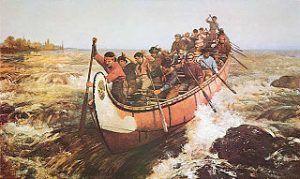
Voyageurs
Compiled & edited by Kathy Alexander/Legends of America, updated December 2022.
Also See:
Chippewa – People of the Great Lakes (Ojibwe)
Grand Portage National Monument
North West Fur Company Trading Post
Source: National Park Service


